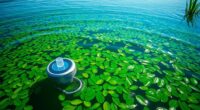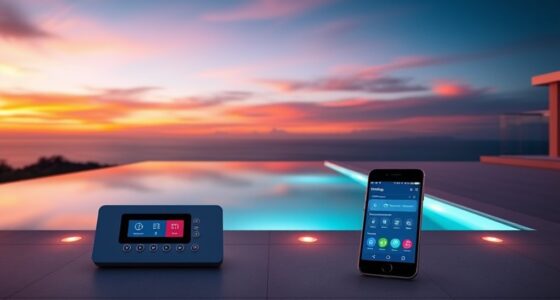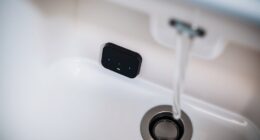To create the mesmerizing “endless” edge effect, your system relies on carefully chosen pumps that guarantee steady water flow, while filters keep the water clear and hygienic. The weir is designed to guide water smoothly over the edge, enhancing the illusion of infinite flow. Proper integration and maintenance of these components are essential for a seamless, tranquil display. Keep exploring, and you’ll uncover how each part works together to produce this stunning visual.
Key Takeaways
- Pumps circulate water smoothly, maintaining continuous flow and system stability essential for the “endless” edge illusion.
- Proper weir design and placement create a seamless, flat water surface that appears to extend infinitely.
- Filters ensure water clarity and quality, preventing debris and algae from disrupting the visual effect.
- Synchronizing pump, filter, and weir components ensures balanced operation and consistent water flow.
- Regular maintenance and durable material choices sustain system performance and the tranquil, infinite water appearance.
Understanding the Role of Pumps in Water Features

Pumps are the heart of any water feature, driving the movement and circulation of water to create a dynamic, lively display. They push water through the system, ensuring continuous flow and preventing stagnation. When you choose a pump, consider the flow rate needed for your feature’s size and design. A powerful pump can generate the desired movement, whether it’s gentle ripples or a vigorous cascade. You also need to account for head height—the vertical distance water must travel—and friction losses within pipes. Proper pump placement is essential for efficiency and maintenance. By maintaining the right flow, your pump helps keep the water clear, aerated, and visually appealing, making your water feature a mesmerizing focal point. Regular inspections and understanding the power consumption of your pump can also help optimize its performance and longevity.
Types of Pumps Used in Endless Edges

To achieve the seamless, flowing appearance of an endless edge, selecting the right type of pump is crucial. You’ll typically choose between centrifugal, submersible, or inline pumps. Centrifugal pumps are popular because they generate high flow rates and are easy to maintain, making them ideal for large water features. Submersible pumps sit directly in the water, saving space and reducing noise, perfect for smaller or decorative edges. Inline pumps are installed outside the water and are known for their durability and efficiency, especially in continuous operation. Each pump type has advantages depending on your design’s size, flow needs, and aesthetic. Ensuring proper installation and venting is essential for maintaining safe operation and preventing issues like gas buildup or fire hazards. Choosing the right pump ensures consistent water movement, which is essential for maintaining the smooth, endless edge effect.
How Pumps Maintain Continuous Water Flow

Pumps come in various types, each playing a specific role in keeping water moving smoothly. They work to maintain steady pressure, so the flow remains continuous and reliable. Regular maintenance and troubleshooting are essential to prevent disruptions and keep the system running seamlessly. Properly tuned systems can also benefit from efficient engine performance, which helps ensure consistent operation.
Pump Types and Roles
Understanding the different types of pumps is essential because each one plays a specific role in maintaining a continuous water flow over the edge. Centrifugal pumps are common; they use spinning impellers to move water efficiently. Submersible pumps operate underwater, ideal for deep setups. Peristaltic pumps gently push water through flexible tubes, perfect for delicate flows. The choice of pump also influences the overall water flow and system efficiency.
Ensuring Consistent Pressure
Maintaining a steady water flow over the edge requires more than just selecting the right pump; it also depends on how well the system can sustain consistent pressure. Pumps must adapt to changing conditions to ensure continuous flow. To achieve this, systems often include:
- Pressure regulators that adjust flow based on demand
- Variable speed drives that modify pump speed dynamically
- Buffer tanks to stabilize pressure fluctuations
- Proper piping design to reduce resistance and turbulence
- Regular monitoring and maintenance to prevent pressure drops and ensure optimal operation system stability.
These components work together to prevent pressure drops that could disrupt the waterfall’s seamless appearance. By carefully controlling pressure, you ensure the water flows smoothly and consistently, creating the mesmerizing, endless edge effect you desire. Maintaining this balance is key to a visually stunning, reliable water feature.
Maintenance and Troubleshooting
Regular maintenance and prompt troubleshooting are essential to keeping the water flowing smoothly over the edge. You should check your pump regularly for debris, wear, or leaks that could impair performance. Clean or replace filters as needed to prevent clogs that reduce flow. Listen for unusual noises or vibrations, which may indicate mechanical issues requiring attention. If the flow slows unexpectedly, inspect for blockages or air leaks in the intake line. Ensure the pump’s impeller is free of damage or buildup. Keeping electrical connections secure and inspecting the power supply can prevent outages. Address problems early to avoid more extensive damage or system failure. Regular upkeep guarantees your water feature remains reliable, beautiful, and safe, providing endless enjoyment over the edge. Additionally, understanding the importance of hydrocolloid technology can help you choose the most effective acne patches for your skin needs.
The Function of Filters in Water Clarity and Quality
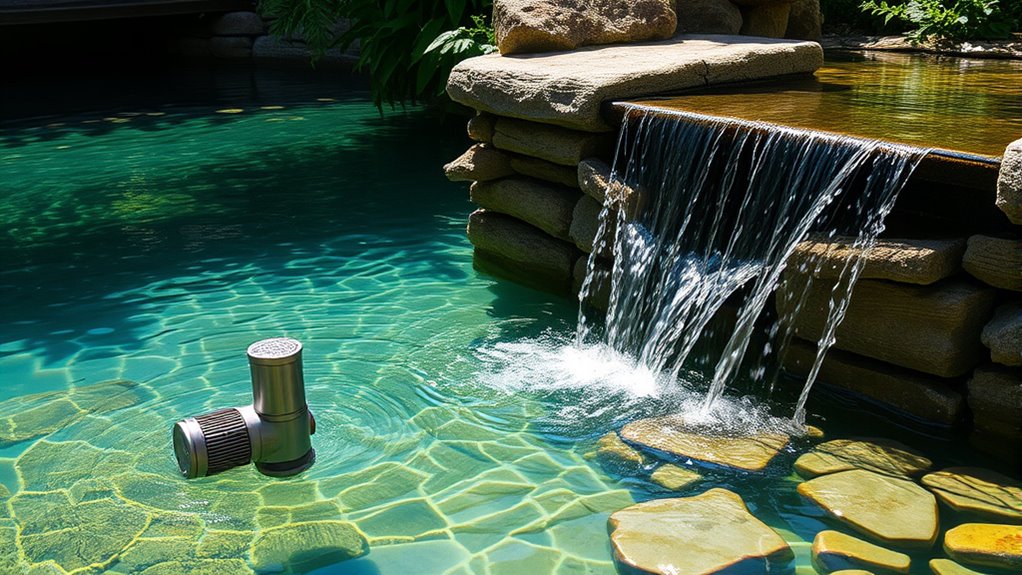
Have you ever wondered how pools stay crystal clear and inviting? Filters play a crucial role in maintaining water clarity and quality. They trap dirt, debris, oils, and algae, preventing them from circulating and clouding the water. Without effective filtration, contaminants quickly accumulate, impacting both appearance and safety. A well-functioning filter system ensures your water stays clean, fresh, and hygienic. Proper workspace organization can also contribute to more efficient maintenance routines, ensuring your filtration system functions optimally.
Different Filtering Technologies for Water Features

Different filtering technologies are essential for keeping water features like fountains, waterfalls, and cascades clean and functional. They remove debris, algae, and contaminants, ensuring clear, healthy water. Common options include mechanical filters, which trap physical debris; biological filters, which use beneficial bacteria to break down organic matter; and chemical filters, like activated carbon, that absorb impurities. Each technology suits different needs and water conditions. Consider your feature’s size, flow rate, and maintenance when choosing a filter. Here’s a quick comparison:
| Filter Type | Function |
|---|---|
| Mechanical | Traps debris and particles |
| Biological | Breaks down organic matter |
| Chemical | Absorbs impurities |
| Combination | Uses multiple methods |
The Design and Placement of Weirs for Seamless Transitions

To create smooth shifts, you need to carefully consider where you place your weirs for ideal flow. The right flow change techniques and material choices can make your water feature look seamless. Paying attention to design details ensures your weir integrates perfectly with the overall system. Incorporating proper placement and selection of UST projectors and ALR screens can enhance the visual harmony of your display environment.
Optimal Weir Placement
Effective weir placement is essential for ensuring smooth water shifts within the system. You want to position weirs where they can control flow without causing turbulence or backflow. Proper placement considers the system’s topography, flow rate, and desired water level transitions. Misplaced weirs can disrupt circulation, leading to uneven water distribution or increased energy consumption. To optimize weir placement, consider:
- Aligning with natural flow paths for minimal resistance
- Positioning at points where water velocity naturally changes
- Ensuring easy access for maintenance and adjustments
- Avoiding locations prone to debris accumulation or sediment build-up
- Recognizing the importance of flow regulation to maintain consistent water levels and system efficiency
Flow Transition Techniques
Achieving seamless water progressions requires careful design and strategic placement of weirs. To guarantee smooth flows, you should consider how water shifts over the weir’s edge, minimizing turbulence and splashing. Gradual slopes or stepped designs can help create a gentle, continuous flow, reducing disturbances downstream. Incorporating a slight incline or curved shape directs water naturally, preventing abrupt changes that disrupt the aesthetic. You also want to position weirs at points where flow velocity can be controlled effectively, avoiding sharp drops that cause splashing or aeration issues. Using multiple small weirs or adjustable features allows for fine-tuning flow rates, maintaining a consistent, visually appealing edge. Proper flow transition techniques help sustain the “endless” illusion and ensure the system remains functional and enchanting. Additionally, understanding how water retention influences flow dynamics can improve the overall stability of the water feature.
Material and Design Choices
Choosing the right materials and shapes for your weirs considerably influences the flow’s smoothness and visual appeal. Material selection affects durability, transparency, and maintenance, while shape determines how seamlessly water shifts over the edge. Opt for smooth, non-corrosive surfaces like acrylic or stainless steel to reduce turbulence and enhance clarity. Consider the weir’s profile—curved, flat, or stepped—to control flow velocity and create a natural look. Proper placement guarantees even flow distribution and minimizes splashing. To elevate your design, focus on:
- Using transparent materials for unobstructed views
- Employing curved shapes for gentle transitions
- Incorporating textured surfaces to reduce noise
- Positioning weirs to optimize flow and aesthetic balance
How Weirs Facilitate the “Endless” Visual Effect
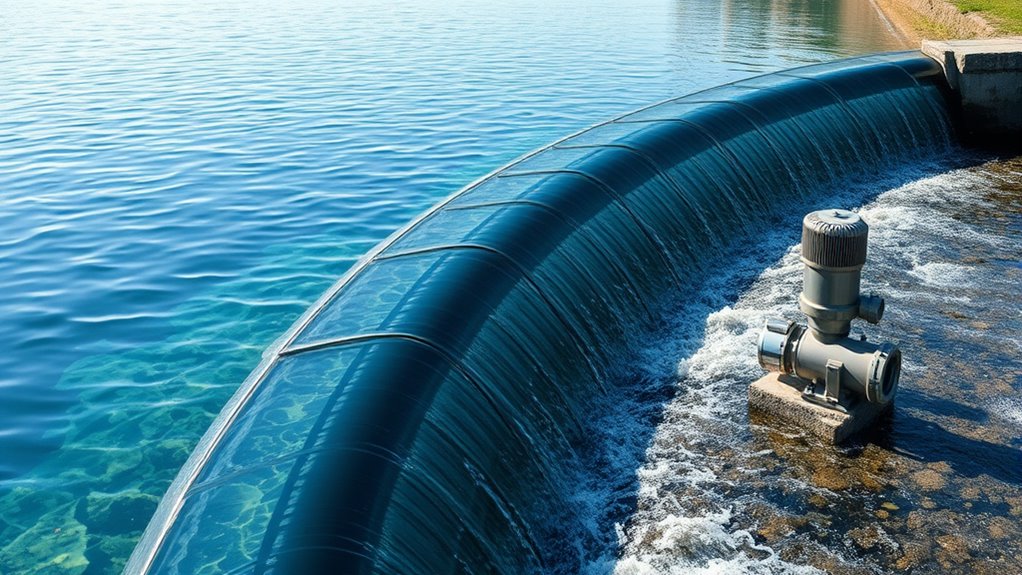
Weirs play a crucial role in creating the mesmerizing “endless” edge effect by maintaining a steady, uniform flow of water over the edge. This consistent flow eliminates splashes and turbulence, giving the illusion that water extends infinitely. The design of the weir ensures a smooth, flat surface, making it appear as if the water seamlessly continues beyond the edge. By controlling the height and shape of the weir, you can achieve the perfect visual continuity, creating a seamless transition between the pond and the surrounding environment. This subtle yet powerful technique draws your eye along the water’s edge, enhancing the tranquil, infinite appearance. Properly designed weirs are essential for maintaining the aesthetic and calming effect that makes the “endless” edge so captivating.
Integrating Pump, Filter, and Weir Systems for Optimal Performance

To guarantee your pond’s “endless” edge functions smoothly and looks stunning, you need to carefully integrate the pump, filter, and weir systems. Proper coordination ensures consistent water flow and clarity, enhancing the visual effect. Start by selecting compatible components designed for your pond size and flow rate. Position the pump to optimize circulation without creating turbulence. Ensure the filter maintains water quality efficiently, and the weir is set at an appropriate height for seamless water overflow. Consider these key integration points:
- Synchronize pump and filter operation for balanced flow
- Secure weir placement to maintain the “endless” edge illusion
- Use durable fittings for leak prevention
- Regularly monitor flow rates to prevent clogs and backpressure
This integration creates a harmonious system that maximizes both aesthetics and performance.
Maintenance and Troubleshooting of the System Components

Regular maintenance and prompt troubleshooting are key to keeping your pond’s pump, filter, and weir system functioning smoothly. Regularly check for debris buildup, ensure all connections are secure, and clean filters as needed to prevent clogs. If water flow slows or stops, inspect for blockages or damaged parts. Quick action minimizes damage and keeps your system running efficiently.
| Troubleshooting Step | Action |
|---|---|
| No water flow | Check for clogs, pump power, and valve positions. |
| Reduced filtration | Clean or replace filters; remove debris from intake. |
| Unusual noises | Inspect for loose parts, debris, or motor issues. |
| Leaks or drips | Tighten fittings, replace worn seals, or repair damaged components. |
Innovations and Advances in Water Feature Engineering
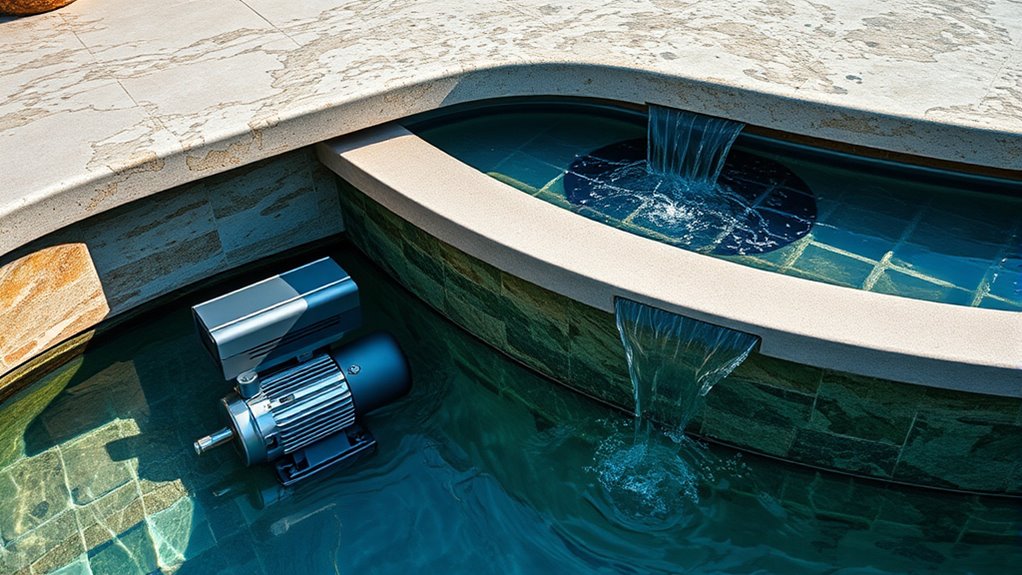
Recent innovations in water feature engineering have markedly enhanced the efficiency, durability, and aesthetic appeal of pond systems. Advanced materials now resist corrosion and wear, extending system lifespan. LED lighting technology provides dynamic, energy-efficient illumination, transforming nighttime views. Smart controls enable remote monitoring and automation, optimizing performance and reducing maintenance. Additionally, eco-friendly pumps and filters minimize energy consumption and environmental impact. Some key advancements include:
- High-efficiency, variable-speed pumps
- Modular, customizable filtration systems
- Durable, corrosion-resistant materials
- Intelligent automation and sensor integration
These innovations empower you to design sustainable, low-maintenance water features that captivate visually and perform reliably over time. Staying abreast of these developments guarantees your system remains innovative, efficient, and visually stunning.
Frequently Asked Questions
How Do Environmental Factors Affect Pump and Filter Performance?
Environmental factors markedly impact your pump and filter performance. High temperatures can cause overheating, reducing efficiency and lifespan. Cold weather may lead to freezing, blocking flow and damaging components. Debris, leaves, or dirt from the environment can clog filters, making them work harder and decreasing flow rates. Humidity and exposure to chemicals or pollutants can corrode parts. By monitoring these factors, you can maintain ideal performance and extend your equipment’s longevity.
What Are the Energy Consumption Considerations for These Water Systems?
Did you know that water systems can account for up to 30% of a building’s energy use? When managing these systems, you should consider efficiency to save costs and reduce environmental impact. Opt for energy-efficient pumps and filters, maintain equipment regularly, and use sensors to optimize operation times. These steps can markedly cut energy consumption, making your water system more sustainable and cost-effective over the long term.
Can These Systems Be Customized for Different Pool or Pond Sizes?
Yes, you can customize these systems for different pool or pond sizes. You’ll want to select appropriately sized pumps, filters, and weirs to match your water feature’s volume and flow requirements. Adjusting the system’s components guarantees efficient operation and ideal water circulation. Consulting with professionals or manufacturers helps you choose the right specifications, making sure your setup performs well regardless of your pool or pond’s dimensions.
What Safety Features Are Integrated Into Pump and Weir Designs?
You’ll find that safety features like automatic shut-off, safety covers, and secure grates are integrated into pump and weir designs. These features prevent accidental contact with moving parts, reduce entrapment risks, and guarantee safe operation. Many systems also include sensors to detect malfunctions or blockages, prompting immediate shut-off. These safety measures give you peace of mind while enjoying your pool or pond, knowing the equipment is designed to protect users.
How Do System Components Impact Overall Water Conservation Efforts?
You can improve water conservation by understanding how each component works together. Efficient pumps reduce energy use, while smart filters minimize waste. Weirs control water flow precisely, preventing unnecessary runoff. When these parts are optimized, they minimize water loss and energy consumption. This synergy helps you save water and lower costs, making your system more sustainable. Proper maintenance guarantees these components function at peak efficiency, further enhancing conservation efforts.
Conclusion
Think of your water feature as a modern Prometheus, endlessly fueling beauty and serenity through its pump, filter, and weir. When these elements work in harmony, they reveal a perpetual dance of water—alive, clear, and mesmerizing. Keep them maintained, and your creation becomes a timeless symbol of innovation and balance—reminding us that true artistry lies in seamless harmony beneath the surface. Embrace this system, and your water’s endless allure will never fade.


